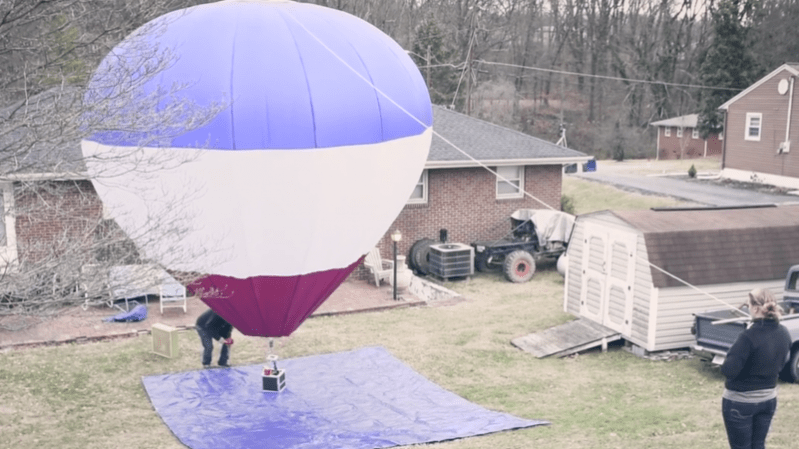Calling [Matt Barr]’s remote controlled hot air balloon a miniature is a bit misleading. Sure, it’s small compared with the balloons that ply cold morning skies with paying passengers and a bottle of champagne for the landing. Having been in on a few of those landings, we can attest to the size of the real thing. They’re impressively big when you’re up close to them.
While [Matt]’s balloon is certainly smaller, it’s not something you’d just whip together in an afternoon. Most of [Matt]’s build log concentrates mainly on the gondola and its goodies — the twin one-pound camp stove-style propane tanks, their associated plumbing, and the burner, a re-tasked propane weed torch from Harbor Freight. Remote control is minimal; just as in a full-size balloon, all the pilot can really do is turn the burner on or off. [Matt]’s approach is a high-torque RC servo to control the burner valve, which is driven by an Arduino talking to the ground over a 2.4-GHz RF link. The balloon is big enough to lift 30 pounds and appears to be at least 12 feet tall; we’d think such a craft would run afoul of some civil aviation rules, so perhaps it’s best that the test flight below was a tethered one.
Sadly, no instructions are included for making the envelope, which would be a great excuse for anyone to learn a little about sewing. And knowing how to roll your own hot air balloon might come in handy someday.
















I’ve been following the Cloudhoppers group on Facebook for a while now… these are “single-person” hot air balloons, usually with a chair instead of a gondola attached. One day…
There was the case of the lawnchair balloonist in California. He got a rare Darwin Award while living to tell about it. He did have to pay a $4000 fine for “driving” without a license to the FAA. As far as exiting East Germany before the wall came down, I would have chosen a device like a powered hang glider type aircraft, not a brightly lit hot air balloon.
There was an entire family that made it out of the Czechoslovak Republic into West Germany in a DIY ballon…apparently it’s not as bright as one might think ;-)
A ballon had the advantage of being nearly silent, so if there was a low cloud layer, foot guards and local folk that collaborated with the police didn’t hear anything.
But a heavier-then-air aircraft is obviously superior, as you get to choose where you go and where you land :D
I think that was even the basis for a MacGyver episode
I can’t even fly a kite in my area as it is controlled airspace (not that the law stops some people), but even if I travelled to a more remote location I’d still need a licence to fly that mini balloon. Obviously getting the balloon to fly itself would be idea, have an AI that tracked altitude and drift speed/direction to map out the local conditions and know how to steer by changing altitude the way a human operator would. It would have to be continuous learning code and not a pretrained neural network. Having part of the balloon contain a helium cell would let you have a very small negative buoyancy which would extend it’s range a lot.
The burner isn’t the only control; on a real hot air balloon you also have a “valve” which can be pulled open at the top of the envelope, releasing hot air and guaranteeing quick descent. Without this a controlled landing is almost impossible.
Excellent point. But, maybe where it is so small in comparison the valve is unnecessary.
So you are saying the laws of buoyancy do not scale? That doesn’t seem correct.
More of a hysteresis issue I think. I could be very wrong, and I’m fine with that.
BUT I NEED TO KNOW!!!
Laws of buoyancy still apply, but when you have smaller balloon, you have bigger surface-to-volume ratio so your gas cools faster.
Good point. The canopy we used does actually have a vented top. I forgot to put the stuff on the project log about the canopy itself. I will add some more pictures and some information about the canopy the next time we take it out.
Simple aluminium and drain cleaner (careful, exothermic) gives you the hydrogen to go a lot higher, and stay aloft a lot longer. Cut the tether though, and you’re in a painful world of liability where I live.
There’s the constant problem of it being a little too much combustable :P
Also, I believe that HCl and zinc is considerably cheaper, albeit needing a bubbler to scrub gasseous HCl out of the resulting hydrogen…
Skip the drain cleaner and use just the active ingredient…lye. Sodium or Potassium Hydroxide. You can then adjust lye solution to produce more or less H2/min. Also, this reaction results in Aluminum oxide “sludge”…which with enough heat you can smelt back down to metallic Al and do it again….
P.S. a balloon filled with molecular hydrogen at atmospheric pressure would be many orders safer than an open flame pressurized propane burner/tank…and if you don’t dope the balloon in thermite like the Hindenburg…MUCH safer lol
Very nice! But you should put a video camera in that gondola. I put a key chain camera on a model rocket: https://www.youtube.com/user/M0HBR/videos
Good call. I’ll do it the next time we take it out and add it to the project log. Your link goes to your main channel page. Do you have a direct link to the rocket footage vid?